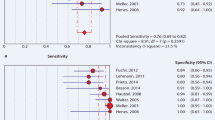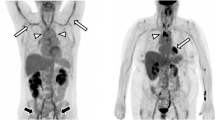Abstract
The purpose of this study was to identify clinical and laboratory parameters that may improve the effectiveness of the use of fluorodeoxyglucose positron emission tomography (18 F-FDG PET)(/CT) for diagnosing large vessel vasculitis (LVV), and secondarily to assess the contribution of 18 F-FDG PET/CT in finding other diagnoses for patients without signs of LVV on the scan. A multicenter retrospective study of 18 F-FDG PET(/CT) scans performed between January 2000 and December 2009 for clinical suspicion of LVV was conducted. A total of 304 18 F-FDG PET(/CT) scans were included, of which 62 (20%) were positive and 242 (80%) were negative for LVV. Univariate analysis showed that patients with a positive scan were older (65.9 ± 13.4 versus 58.6 ± 16.5 years, p = 0.002), were more frequently female (76% versus 55%, p = 0.002), more often had a history of temporal arteritis (10% versus 3%, p = 0.044), less frequently had artralgia (31% versus 67%, p = 0.000), and had higher thrombocyte counts (434 ± 161 versus 373 ± 168 × 109/l, p = 0.049) and a higher erythrocyte sedimentation rate (ESR) (72.6 ± 31.0 versus 51.4 ± 30.5 mm/h, p = 0.001) than patients with a negative scan. In the multivariate analysis, only artralgia (OR 0.091; 95% CI 0.023–0.366) and ESR (OR 1.024; 95% CI 1.002–1.046) remained statistically significant predictors. The presence of artralgia is a statistically significant negative predictor and an elevated ESR a statistically significant positive predictor of LVV showing up on 18 F-FDG PET(/CT). A reliable prediction of the outcome of the scan, based on these two parameters, is not possible however. 18 F-FDG PET(/CT) allows early diagnosis of LVV and may discover occult inflammatory or neoplastic disorders.



Similar content being viewed by others
References
Jennette JC, Falk RJ, Andrassy K et al (1994) Nomenclature of systemic vasculitides. Proposal of an international consensus conference. Arthritis Rheum 37:187–192
Gornik HL, Creager MA (2008) Aortitis. Circulation 117:3039–3051
Levine SM, Hellmann DB (2002) Giant cell arteritis. Curr Opin Rheumatol 14:3–10
Walter MA (2007) [(18)F]fluorodeoxyglucose PET in large vessel vasculitis. Radiol Clin North Am 45:735–744, viii
Salvarani C, Cantini F, Hunder GG (2008) Polymyalgia rheumatica and giant-cell arteritis. Lancet 372:234–245
Bongartz T, Matteson EL (2006) Large-vessel involvement in giant cell arteritis. Curr Opin Rheumatol 18:10–17
Janssen SP, Comans EH, Voskuyl AE, Wisselink W, Smulders YM (2008) Giant cell arteritis: heterogeneity in clinical presentation and imaging results. J Vasc Surg 48:1025–1031
Cantini F, Niccoli L, Storri L et al (2004) Are polymyalgia rheumatica and giant cell arteritis the same disease? Semin Arthritis Rheum 33:294–301
Blockmans D, Stroobants S, Maes A, Mortelmans L (2000) Positron emission tomography in giant cell arteritis and polymyalgia rheumatica: evidence for inflammation of the aortic arch. Am J Med 108:246–249
Gonzalez-Gay MA, Garcia-Porrua C, Llorca J, Gonzalez-Louzao C, Rodriguez-Ledo P (2001) Biopsy-negative giant cell arteritis: clinical spectrum and predictive factors for positive temporal artery biopsy. Semin Arthritis Rheum 30:249–256
Mari B, Monteagudo M, Bustamante E et al (2009) Analysis of temporal artery biopsies in an 18-year period at a community hospital. Eur J Intern Med 20:533–536
Taylor-Gjevre R, Vo M, Shukla D, Resch L (2005) Temporal artery biopsy for giant cell arteritis. J Rheumatol 32:1279–1282
Chong EW, Robertson AJ (2005) Is temporal artery biopsy a worthwhile procedure? ANZ J Surg 75:388–391
Hayreh SS, Podhajsky PA, Raman R, Zimmerman B (1997) Giant cell arteritis: validity and reliability of various diagnostic criteria. Am J Ophthalmol 123:285–296
Maksimowicz-McKinnon K, Clark TM, Hoffman GS (2009) Takayasu arteritis and giant cell arteritis: a spectrum within the same disease? Medicine (Baltimore) 88:221–226
Park MC, Lee SW, Park YB, Chung NS, Lee SK (2005) Clinical characteristics and outcomes of Takayasu’s arteritis: analysis of 108 patients using standardized criteria for diagnosis, activity assessment, and angiographic classification. Scand J Rheumatol 34:284–292
Mwipatayi BP, Jeffery PC, Beningfield SJ et al (2005) Takayasu arteritis: clinical features and management: report of 272 cases. ANZ J Surg 75:110–117
Kissin EY, Merkel PA (2004) Diagnostic imaging in Takayasu arteritis. Curr Opin Rheumatol 16:31–37
Ahmadi-Simab K, Hellmich B, Holl-Ulrich K, Fleischmann C, Dourvos O, Gross WL (2007) Acute coronary syndrome in Takayasu arteritis without elevation of acute phase parameters. Rheumatology (Oxford) 46:554–555
Hoffman GS, Ahmed AE (1998) Surrogate markers of disease activity in patients with Takayasu arteritis. A preliminary report from The International Network for the Study of the Systemic Vasculitides (INSSYS). Int J Cardiol 66(Suppl 1):S191–S194
Andrews J, Mason JC (2007) Takayasu’s arteritis—recent advances in imaging offer promise. Rheumatology (Oxford) 46:6–15
Bartels AL, Zeebregts CJ, Bijl M, Tio RA, Slart RH (2009) Fused FDG-PET and MRI imaging of Takayasu arteritis in vertebral arteries. Ann Nucl Med 23:753–756
Meave A, Soto ME, Reyes PA et al (2007) Pre-pulseless Takayasu’s arteritis evaluated with 18F-FDG positron emission tomography and gadolinium-enhanced magnetic resonance angiography. Tex Heart Inst J 34:466–469
Kaku B, Higuchi T, Kanaya H et al (2006) Usefulness of fluorine-18-fluorodeoxyglucose positron emission tomography in a patient with Takayasu’s arteritis associated with antiphospholipid syndrome. Int Heart J 47:311–317
Weaver FA, Kumar SR, Yellin AE et al (2004) Renal revascularization in Takayasu arteritis-induced renal artery stenosis. J Vasc Surg 39:749–757
Henes JC, Muller M, Krieger J et al (2008) [18F] FDG-PET/CT as a new and sensitive imaging method for the diagnosis of large vessel vasculitis. Clin Exp Rheumatol 26:S47–S52
Meller J, Strutz F, Siefker U et al (2003) Early diagnosis and follow-up of aortitis with [(18)F]FDG PET and MRI. Eur J Nucl Med Mol Imaging 30:730–736
Meller J, Grabbe E, Becker W, Vosshenrich R (2003) Value of F-18 FDG hybrid camera PET and MRI in early Takayasu aortitis. Eur Radiol 13:400–405
Blockmans D, Bley T, Schmidt W (2009) Imaging for large-vessel vasculitis. Curr Opin Rheumatol 21:19–28
Pipitone N, Versari A, Salvarani C (2008) Role of imaging studies in the diagnosis and follow-up of large-vessel vasculitis: an update. Rheumatology (Oxford) 47:403–408
Zerizer I, Tan K, Khan S et al (2010) Role of FDG-PET and PET/CT in the diagnosis and management of vasculitis. Eur J Radiol 73:504–509
Kobayashi Y, Ishii K, Oda K et al (2005) Aortic wall inflammation due to Takayasu arteritis imaged with 18F-FDG PET coregistered with enhanced CT. J Nucl Med 46:917–922
Ell PJ (2006) The contribution of PET/CT to improved patient management. Br J Radiol 79:32–36
Hautzel H, Sander O, Heinzel A, Schneider M, Muller HW (2008) Assessment of large-vessel involvement in giant cell arteritis with 18F-FDG PET: introducing an ROC-analysis-based cutoff ratio. J Nucl Med 49:1107–1113
Dunphy MP, Freiman A, Larson SM, Strauss HW (2005) Association of vascular 18F-FDG uptake with vascular calcification. J Nucl Med 46:1278–1284
Besson FL, Parienti JJ, Bienvenu B et al (2011) Diagnostic performance of (18)F-fluorodeoxyglucose positron emission tomography in giant cell arteritis: a systematic review and meta-analysis. Eur J Nucl Med Mol Imaging 38:1764–1772
Balink H, Bruyn GA (2007) The role of PET/CT in Cogan’s syndrome. Clin Rheumatol 26:2177–2179
Dasgupta B (2010) Concise guidance: diagnosis and management of giant cell arteritis. Clin Med 10:381–386
Ezeonyeji AN, Borg FA, Dasgupta B (2011) Delays in recognition and management of giant cell arteritis: results from a retrospective audit. Clin Rheumatol 30:259–262
Mukhtyar C, Guillevin L, Cid MC et al (2009) EULAR recommendations for the management of large vessel vasculitis. Ann Rheum Dis 68:318–323
Schmidt WA, Seifert A, Gromnica-Ihle E, Krause A, Natusch A (2008) Ultrasound of proximal upper extremity arteries to increase the diagnostic yield in large-vessel giant cell arteritis. Rheumatology (Oxford) 47:96–101
Moosig F, Czech N, Mehl C et al (2004) Correlation between 18-fluorodeoxyglucose accumulation in large vessels and serological markers of inflammation in polymyalgia rheumatica: a quantitative PET study. Ann Rheum Dis 63:870–873
Arnaud L, Haroche J, Malek Z et al (2009) Is (18)F-fluorodeoxyglucose positron emission tomography scanning a reliable way to assess disease activity in Takayasu arteritis? Arthritis Rheum 60:1193–1200
Weyand CM, Tetzlaff N, Bjornsson J, Brack A, Younge B, Goronzy JJ (1997) Disease patterns and tissue cytokine profiles in giant cell arteritis. Arthritis Rheum 40:19–26
Weyand CM, Hicok KC, Hunder GG, Goronzy JJ (1994) Tissue cytokine patterns in patients with polymyalgia rheumatica and giant cell arteritis. Ann Intern Med 121:484–491
Blockmans D, De CL, Vanderschueren S, Knockaert D, Mortelmans L, Bobbaers H (2007) Repetitive 18-fluorodeoxyglucose positron emission tomography in isolated polymyalgia rheumatica: a prospective study in 35 patients. Rheumatology (Oxford) 46:672–677
Blockmans D, Maes A, Stroobants S et al (1999) New arguments for a vasculitic nature of polymyalgia rheumatica using positron emission tomography. Rheumatology (Oxford) 38:444–447
Hamrin B, Jonsson N, Hellsten S (1968) “Polymyalgia arteritica”. Further clinical and histopathological studies with a report of six autopsy cases. Ann Rheum Dis 27:397–405
Nuenninghoff DM, Hunder GG, Christianson TJ, McClelland RL, Matteson EL (2003) Incidence and predictors of large-artery complication (aortic aneurysm, aortic dissection, and/or large-artery stenosis) in patients with giant cell arteritis: a population-based study over 50 years. Arthritis Rheum 48:3522–3531
Taniguchi Y, Arii K, Kumon Y et al (2010) Positron emission tomography/computed tomography: a clinical tool for evaluation of enthesitis in patients with spondyloarthritides. Rheumatology (Oxford) 49:348–354
Toriihara A, Seto Y, Yoshida K et al (2009) F-18 FDG PET/CT of polymyalgia rheumatica. Clin Nucl Med 34:305–306
Blockmans D, Coudyzer W, Vanderschueren S et al (2008) Relationship between fluorodeoxyglucose uptake in the large vessels and late aortic diameter in giant cell arteritis. Rheumatology (Oxford) 47:1179–1184
Vanderschueren S, Del BE, Ruttens D, Van B, I, Wauters E, Knockaert DD (2009) Inflammation of unknown origin versus fever of unknown origin: two of a kind. Eur J Intern Med 20: 415–8
Bleeker-Rovers CP, Vos FJ, Mudde AH et al (2007) A prospective multi-centre study of the value of FDG-PET as part of a structured diagnostic protocol in patients with fever of unknown origin. Eur J Nucl Med Mol Imaging 34:694–703
Blockmans D, Knockaert D, Maes A et al (2001) Clinical value of [(18)F]fluoro-deoxyglucose positron emission tomography for patients with fever of unknown origin. Clin Infect Dis 32:191–196
Buysschaert I, Vanderschueren S, Blockmans D, Mortelmans L, Knockaert D (2004) Contribution of (18)fluoro-deoxyglucose positron emission tomography to the work-up of patients with fever of unknown origin. Eur J Intern Med 15:151–156
Balink H, Collins J, Bruyn G, Gemmel F (2009) F-18 FDG PET/CT in the diagnosis of fever of unknown origin. Clin Nucl Med 34:862–868
Meller J, Sahlmann CO, Gurocak O, Liersch T, Meller B (2009) FDG-PET in patients with fever of unknown origin: the importance of diagnosing large vessel vasculitis. Q J Nucl Med Mol Imaging 53:51–63
Acknowledgements
The authors want to express their gratitude to H. Groen, epidemiologist, for his valuable help in analyzing the data.
Disclosures
Both first and second author equally contributed to the manuscript.
Author information
Authors and Affiliations
Corresponding author
Rights and permissions
About this article
Cite this article
Hooisma, G.A., Balink, H., Houtman, P.M. et al. Parameters related to a positive test result for FDG PET(/CT) for large vessel vasculitis: a multicenter retrospective study. Clin Rheumatol 31, 861–871 (2012). https://doi.org/10.1007/s10067-012-1945-0
Received:
Revised:
Accepted:
Published:
Issue Date:
DOI: https://doi.org/10.1007/s10067-012-1945-0




